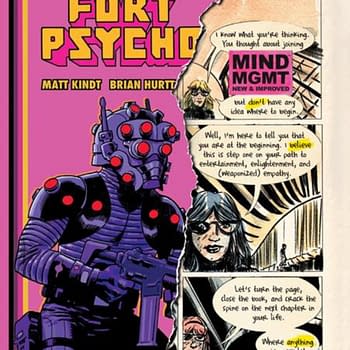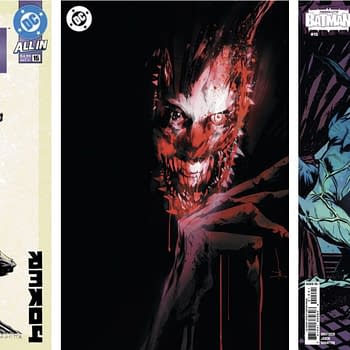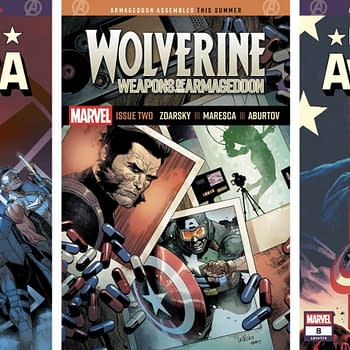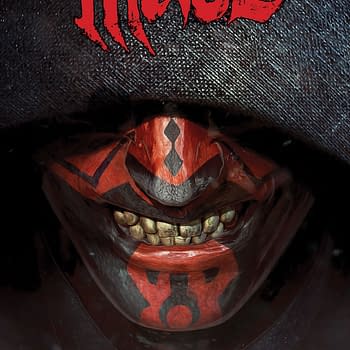Posted in: Comics | Tagged: carmine infantino, comic con, Comics, dc, san diego, sdcc
Remembering Carmine
By Nikolai Fomich
I remember Carmine. I met him once, a few years back at Wizard World in Philadelphia. I had bought a used copy of 1992's The Greatest Flash Stories Ever Told while in college and had brought it to the convention for Carmine to sign, which he happily did. The collection, part of an earlier, superior 'Greatest Ever Told' line put out by DC in the early '90s, featured ten stories with art by Carmine out of sixteen – nine from his classic Flash run from 1956 to 1967, and one earlier Jay Garrick story from 1947. The copy, which I was also lucky enough to get signed by the great Joe Kubert, is lost now, a likely casualty of various moves – though I haven't given up hope yet that it'll turn up, tucked away somewhere among my history books.
Carmine, in the few minutes I interacted with him, was kind and generous, but also seemed somewhat perplexed, as though he wanted to give me, a fan, what I wanted in the experience of meeting him, but couldn't fathom what that something was. For my part, I was simply happy to have shaken hands with the legend. I saw Carmine later, sitting alone away from the crowds, appearing overwhelmed by the thousands of people, and though I would have loved to have spoken with him about the Flash, or Adam Strange, or Elongated Man (or anything really), I thought it better to allow him his peace.
Carmine's dead now, though like any great artist he lives on through his work and influence. Yet for someone who I'd place alongside Kirby, Ditko, and Steranko as the greatest of Silver Age artists – and who, in my opinion, was the best artist DC had seen after Dick Sprang – the number of attendees at the Carmine Infantino Tribute Panel was disappointingly small, especially considering that Carmine had just passed earlier this year.
Regardless, the panel provided an interesting glimpse into Carmine as an artist and as a man, as well as the comic book business of the past. The panel was moderated by Vanguard Productions founder and artist advocate J. David Spurlock (who compiled and edited Carmine's autobiography), and featured graphic designer and Comic Book Artist magazine founder Jon B. Cooke (who designed Carmine's autobiography), Superman scribe extraordinaire Elliot S! Maggin, writer and former DC Comics editor and president Paul Levitz, and comics and television writer Martin Pasko. Spurlock, speaking solemnly, opened by saying that "Carmine was one of the most important people who ever worked in this industry. He was a dear friend and I miss him."
The Dynamic Duo: Julie and Carmine
The panel began with discussion regarding the relationship between Carmine Infantino and Julie Schwartz, whose own Superman-themed tribute panel had occurred on the first day of SDCC 2013. Spurlock remarked upon the duo's importance to DC by saying that "the only team I can compare them to is Stan Lee and Jack Kirby at Marvel. I think that Julie could have – if he wanted to… – taken legitimate co-writing credit on a lot of the material he edited."
Carmine, said Pasko, though having worked under Julie Schwartz for so many years, remained loving and even deferential to Schwartz even after he moved up DC's corporate ladder from art director to editorial director to publisher and president. This was in part "because a great deal of the exposure Carmine's work got, that his reputation had come from, had been from books he had worked on for Julie, such as The Flash and the Adam Strange feature in Mystery in Space."
Even when things became heated between the two men and Julie lost his temper, Carmine would laugh it off. Pasko said that that was "a testament to Carmine's geniality." Spurlock later added that Schwartz was once asked what he thought Carmine did best for DC, to which he responded, "Everything Carmine did was best for DC."
Elliot S! Maggin himself had his fair share of arguments with Schwartz, who was his Superman editor. "My relationship with Julie was like two Jewish boys from the suburbs who would just yell at each other. I would come into his office and we would scream at each other plotting a story. And every once in awhile the screaming would get serious and we would get pissed…Carmine's job in that relationship was to make it all better, and he was very good at that."
The Artist as Editor (and Publisher)
Carmine's relationship to creators as a creator wasn't something that he let wane when he became an editor or later publisher. "He never once let anyone creative forget where his real passions lie," Pasko remarked, stating that Carmine would often walk purposefully through the bullpen area on his way to the men's room. "You'd be standing at the flat files at the center of the bullpen, when suddenly this shadow would fall over you." On one occasion, Pasko was proofreading Adam Strange pages for a reprint, vocally marveling at artwork featuring Adam and Alanna by Carmine, with inks by Murphy Anderson, and talking aloud about how he wished they could capture the original beauty of the art in the construction process. Pasko looked up from the pages and saw Carmine standing behind him, who simply said [Pasko at this point dropped into a humorous Infantino impression], "Yeah, I always thought those two had something going on." Carmine, stated Pasko, was "an unpretentious and often very funny man."
Carmine's tenure as editorial director and publisher remained a focal point throughout the panel. Cooke remarked upon his courage as a publisher, stating that his was an era of "the artist as editor." It was a time, said Levitz, when Marvel was gaining more and more success in the business and there was a feeling of uncertainty regarding the future. "The Batman TV show has happened, its exploded, and its clear this is not going to be a lasting phenomenon. And DC at the time had been a very staid company, the same players had been doing the same thing for a very long time." Carmine shook things up, putting new artists on new books and turning artists like Joe Kubert and Joe Orlando into editors. By the time he himself came into DC, Levitz says, five of the seven editors were already in the Eisner Hall of Fame. "Never had [there been] a comic book company with that wealth of office talent."
Carmine's reign as editorial director between 1967 and 1970 saw the introduction of Bat Lash, Anthro, Cain and Abel, and from Steve Ditko the Creeper and Hawk and Dove. The new Batgirl Barbara Gordon was also introduced and the Phantom Stranger revived – both characters co-created by Carmine himself. Other less successful creations during the time – such as Brother Power the Geek – at least proved Carmine was willing to take risks.
The books DC produced under Carmine were unlike anything DC had done in many years, if ever. "Most of the experiments don't last, don't work, but he keeps trying, he keeps experimenting," Levitz said. "He brings Jack over from Marvel and lets Jack write his own stuff. Launching four inter-connected books these days is a standard technique. At the time it was somewhere between an act of insanity and an act of genius. And that level of courage of a publisher is an astronomic thing I think."
Beyond the Fourth World, Kirby created OMAC, Kamandi, the Demon, and with Joe Simon a new Sandman for DC during Carmine's reign as publisher. New talent Denny O'Neil and Neal Adams were also brought into the company, who together revamped Batman and produced their classic Green Lantern/Green Arrow run. Superman and Wonder Woman were also shaken up and modernized.
Cover Designing
Pasko stated that in many ways, even earlier during his tenure as an art director, Carmine shook thinks up simply by having an artist's perceptive, in a place that hadn't seen one in the editorial department since Shelly Mayer had edited the All-American line in the 1940's. "He was effectively the designer of all the covers, and he brought to those covers a design sense unlike anything that had been seen at DC previously."
During the 1940's, said Pasko, Carmine had illustrated in the DC house style popular at the time, a style heavily influenced by legendary comic strip writer/artist Milton Caniff, famous for Terry and the Pirates and Steve Canyon. Carmine eventually broke from this tradition, and went back to school to study fine art and design, becoming influenced by modern art and minimalism. "His visual orientation," Spurlock said, "became all about design and storytelling and that's when he created the style he's really known for."
According to the panelists, Carmine's artistry shone through his cover layouts, a fact that anyone familiar with DC Comics during the Silver Age and early Bronze Age can attest. Pasko described his own experience of pitching a Superman cover idea to Schwartz, who took it over to Carmine. This resulted in "one of the most eye-opening, educational experiences I ever had." The cover pitch "was a long shot, past the back of Lois' head to Superman. "Carmine sketches it, starts with geometric shapes, in very loose blue pencil, tightens it up a bit with black pencil, and he's completely changed the angle I had envisioned. I'm watching an idea I had in my head being turned 360 degrees and made about 1000 times more dynamic. It was done in about 60 seconds."
According to Spurlock, no matter who did the finished art, whether Neal Adams or Joe Kubert or Nick Cardy, most of DC's covers were laid out by Carmine. "When he got an offer from Marvel in the mid-60's to go over, Stan offered him more money. And then the top brass at DC found out and took him out to lunch and that's when he first became an executive. He was to design the whole line of covers – but it wasn't as if he was doing the art on them all."
Changing DC
But even as Carmine went up the corporate ladder, he kept all the jobs below him. Spurlock relayed a story Carmine had told him about someone from Warner Brothers coming in to interview the executives, and at the end of the interview telling Carmine that he was doing the job of five men. Carmine's responded by saying, "I don't know what that means, I just do what has to be done," said Spurlock.
"And I think that when he left, you could add them up on who was hired and who was promoted that it took about five guys to replace him."
Levitz remarked that Carmine's greatest work at DC was when he stuck closest to the creative side of the business. "I think one of the saddest things for Carmine was that in his later years he wasn't able to focus on the acclaim that he had earned as one of the great artists of the field and he became more and more fixated on the work he had done in a relatively short period of time on the business side of the company. And that was not the shinning period of his career. You look at the effect he had on the covers, you look at the effect he had on picking creative people, recruiting young artists, the closer he stayed to the creative process, the better his work had been."
Carmine's creative decisions, said Pasko, ranged from insisting that the editors insist their long time artists update their swipe files, "so that Lois Lane was dressing like the 1970's or the late 1960's instead of the 1950's," to creating inspired art teams like Curt Swan and Murphy Anderson, who first collaborated on Superman covers.
Carmine encouraged a far more lax attitude at DC offices than had been seen before. A small coffee room in between DC Comics and a news distribution company, with coffee machines and extra copies of Playboy lying around, "became a community center for the lost boys," said Levitz, where Neal Adams drank coffee and did the covers, live models came in on occasion, and editors did their plotting.
According to Pasko, Carmine's move toward a more lax environment was part of his sense of urgency concerning DC's image. Carmine had "a very strong sense that…the world of American popular culture was changing dramatically, and that DC's future depended upon it shaking off its staid image." Pasko believes that the disastrous attempt at 'hipness' by DC in the mid-60's – the short-lived Go-Go Checks era – was something remembered by Carmine, and that that sort of gimmickry was something he never wanted to happen again. "And…to the extent that it was possible in terms of the editorial staff Carmine inherited as opposed to the younger, hipper artists he did bring in…I think he did a fairly good job of it."
Maggin recalled going to Carmine about his ideas for a Superman movie. After first going to Schwartz about it and being told that "heroes are over, sociologically heroes are over," he wrote a memo and sent it to Carmine, about why heroes were back. "He had me come in, and talk about it, and talk about why it was important to have a Superman movie, and I got all excited and I wrote a treatment for a script, and next thing I knew Mario Puzo's in the office looking in the library with Nelson Bridewell, and Carmine says, "Hey come here! I want you to meet Mario Puzo." I spent two days smoking Cuban cigars with Mario Puzo. It was great."
Carmine and Neal, Carmine and Jack
A lot of artists, said Spurlock, owed a lot to Carmine, including Neal Adams and Jack Kirby. "Neal was according to Neal a self-made man. And there's nobody I have more respect for than Neal. But I said to him one day, I said, "come on. If it wasn't for Carmine you'd still be drawing Jerry Lewis. And Neal's response was, "Jerry Lewis was good! I could draw two pages in the time it took me to draw one page of Batman, I was making money." And I said, "Yeah but these guys wouldn't be standing in line paying ten to twenty dollars for an autograph if you were still drawing Jerry Lewis."
And then there's Jack Kirby. Kirby was not welcome at DC due to a situation that had happened between him and Jack Schiff in the 1950's, and as a result nobody was courting the King over at DC. But once Kirby called Carmine, the DC editorial director became very interested. "But it was far from as easy as that," said Spurlock. "Carmine had to really go to bat for Jack, to get Jack back over, for DC to allow Jack to come back. And he went to bat for lots of people. I know a lot of stories, some to be told publicly and some not, about Carmine going to bat, because some of them could make me cry and I don't like to cry in public."
On Carmine's Popularity
Levitz reminded attendees that in the 1960's, Marvel talents weren't the only ones recognized. "You look back on comics history, you look back on the effect Marvel had, and it's very easy to say that everybody must have thought of Jack and Steve Ditko as the two most important artists of the 1960s." But Carmine, says Levitz, won best artist for the fan awards from 1961 to 1964, when Marvel was being born. "The fact that fans loved his work mattered to him. And he was perfectly happy connecting to them. He was happy to have those of us who were doing the fanzines. I think Marty had the same experience I had when he was doing his fanzine as a kid." The door, Levitz said, "whether he was editorial director or publisher or whatever title he was wearing – was open to these fans." He would welcome fans in, ask them what they thought of the books, and told them about what they were planning to do. "And that was a very unusual reaction and actually a very different reaction, even from Marvel's at the time, even though Marvel had the very fan friendly public voice saying how cool they were, and how much they loved the fans. But the offices were much more open at DC at that time, and I think that had to do a lot with Carmine individually."
As the panel neared its end, Spurlock thanked the audience for attending, and said, "I think that this room should have 6000 people in it, and I want to thank everyone who came today." He added, to laughter, that, "I think that this room might have had 6000 people in it if Carmine had hair, and if he was pretty, and if he had a sweet voice, and if he went around plastering his name on everything like Stan did. And I love Stan, but you know there are just different odd things that seem to work and capture large audiences. He had a large audience through his work, but sometimes he didn't know how to… [Carmine would say], "You know, I shake their hands, I sign the autographs, but after that I don't know what to say to them.""
Bonding with New Artists
Spurlock also spoke about how a whole generation of new talent came in thanks to Carmine opening the doors, from Bernie Wrightson, to Michael Kaluta, to Walt Simonson, to Howard Chaykin.
Levitz said that, "A lot of the young artists from that period talk about the experience of Carmine seeing their portfolio, and walking down the hall with him to one editor or another, and Carmine saying, "Here give him a script.""
Carmine was a mentor to many artists, said Cooke, pointing to the Nightmaster Showcase issues by Bernie Wrightson and Michael Kaluta. "They're very crude but Carmine saw something in [Wrightson's] work. Bernie was so late with that issue, he should have been fired from DC forever, but there was a connection, and if you talk to Bernie to this very day, if you talk to Michael to this very day, there really was a bond they established, and this strong relationship is [still] appreciated."
Sergio Aragonés also began working for DC during Carmine's tenure. Spurlock said that, "Sergio would go out of his way to greet Carmine as warmly as you could imagine anyone ever greeting anyone. And Wrightson, anytime he would see Bernie, Bernie and Carmine would always embrace each other."
Another artist brought up was "the Jazzy One" himself, John Romita Sr. "One example of influence going more broadly than people would realize is John Romita," said Spurlock. "Nobody thinks of John Romita being influenced by Carmine Infantino but he is very much, and nobody thinks to ask John Romita when they interview him about Carmine, because they don't know that there is a connection." But while working on the John Romita Sketchbook, Romita spoke extensively to Spurlock about Carmine. Romita, said Spurlock, talked about "how he would go over to Carmine's house, and sometimes…bring some of his work, and Carmine would put a tracing paper over it and show him all the stuff he was doing wrong. He would give him lessons, and a lot of those lessons would have to do with negative space, and the shapes. Romita is very famous for his beautiful women, and a lot of the ways he draws beautiful women has to do with the shapes, and that's one of the things he picked up from Carmine."
Creative Freedom, Carmine, and Krigstein
Before the panel closed, Spurlock returned to Carmine's earlier years and the transformation he was undergoing as an artist. "Carmine told me, when he went back to school, and he was going through this change, he had no idea where his art was going to go." Spurlock also said that Carmine told him, "[Bernard] Krigstein would come to his place and watch him draw, question him as Carmine is drawing, [saying] "Why are you doing that, why are you making that distinction," and that Krigstein was diligently taking notes, and so a lot of people don't realize that Krigstein was influenced by Carmine." Carmine, said Spurlock, was beginning to see the direction his art was going in even before consciously realizing it.
Pasko added that Krigstein's best known comics were made for EC, where there existed a far more "supportive environment at that time for visual innovation on the page." Part of the reason for Carmine's creative uncertainty, suggested Pasko, was because Carmine's sensibility and use of design didn't fit into the DC culture of the time, which, said Pasko, "believed in what Ross Andru used to call "straight up and down drawing." Everything was flat, no depth of focus, no forced perspective, very little foreshortening. It had to be very flat and straightforward because there was a belief – mistaken of course – that the kids reading comics wouldn't understand the story any other way." Pasko added that, "I think its fair to say that if Carmine had had the liberating and supportive environment of a publisher like Bill Gaines, and editors like Harvey Kurtzman and Al Feldstein, you probably would have seen Carmine do work very similar to Krigstein at that point."
It was an informative, and sometimes somber panel, a fitting tribute to the recently departed Carmine Infantino, who did much for DC as artist, editor, and president. But it's as an artist that I will forever remember him. Carmine, regardless of any lack of publisher support in his early days, was able to create a minimalist style both dynamic and sleek, and imbue his characters – and even his architecture – with a sense of dignity, thoughtfulness, and grace that lives on through the pages, reminding us that the Silver Age was truly golden.














